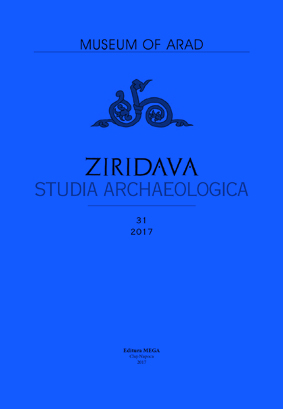An Early Medieval Feature Discovered in Oradea – Salca “Ghețărie” (Petrom Gas Station)
An Early Medieval Feature Discovered in Oradea – Salca “Ghețărie” (Petrom Gas Station)
Author(s): Dan Băcueț-Crișan, Gruia Traian Fazecas, Doru MartaSubject(s): Archaeology
Published by: Editura Mega Print SRL
Keywords: early medieval feature; pit; cauldron; cooking pot; sickle; Avar Period
Summary/Abstract: The spot called Oradea – Salca “Ghețărie” (located in the south-eastern part of the settlement) isknown in specialized literature as a site where archaeological excavations were performed on several occasions,leading to the discovery of vestiges from several historical stages, including the Early Middle Ages.The modernization works of the Petrom gas station in this area, performed in 2000, have triggeredarchaeological investigations through which specialists have identified three archaeological features in sectionS IV/2000 (measuring 8 × 2 m): two dwellings belonging to the Tiszapolgár Culture and one early medievalpit (G. 1/2000). Pit G. 1/2000, oval in shape, was identified at the depth of 0.60 m below the current groundlevel and its trough-shaped bottom was located at the depth of 0.98 m below the present-day ground level. Itsfill was black in color, with a consistent layer of ash and charred wood on the bottom. In the filling of the pit,namely in the layer of ash and charred wood from the bottom, archaeologists discovered parts of four potterycontainers (one cauldron, one bowl, one handless cooking pot, and one fragment from the base of another pot)and an iron sickle.The analogies found for the artifacts discovered in this feature belong to a chronological stage starting inthe 8th century and ending in the 10th century, but focused more on the 8th and 9th centuries. For the chronologicalidentification of this archaeological feature one must turn to the early medieval vestiges discoveredin its proximity. The spot where dwelling L. 1/1999, dated to the end of the 8th century – beginning of the 9thcentury, is located 100 m away from the feature under analysis here. It is thus very likely that the two features(dwelling L. 1/1999 and pit G. 1/2000) belonging to the same chronological horizon were once part of thesame settlement. The fact that the handless cooking pot was deformed/discarded during the firing processindicates that a pottery kiln (or several kilns), that might be identified through future researches, may havefunctioned part of the 8th–9th centuries habitation in Oradea – Salca “Ghețărie”. On the same site, in the“Lotus Market” area (located 400 m away from the spot where the artifacts presented here were discovered)specialists have researched a household oven that belongs to a much later habitation horizon (11th–12thcenturies).The archaeological vestiges discovered so far in Oradea – Salca “Gheţărie” indicate the fact that this terracewas inhabited between the 8th and the 9th centuries. Few data are available so far on this habitation, but futureextended archaeological researches might enrich them.
Journal: Ziridava. Studia Archaeologica
- Issue Year: 31/2017
- Issue No: 1
- Page Range: 215-228
- Page Count: 13
- Language: English

